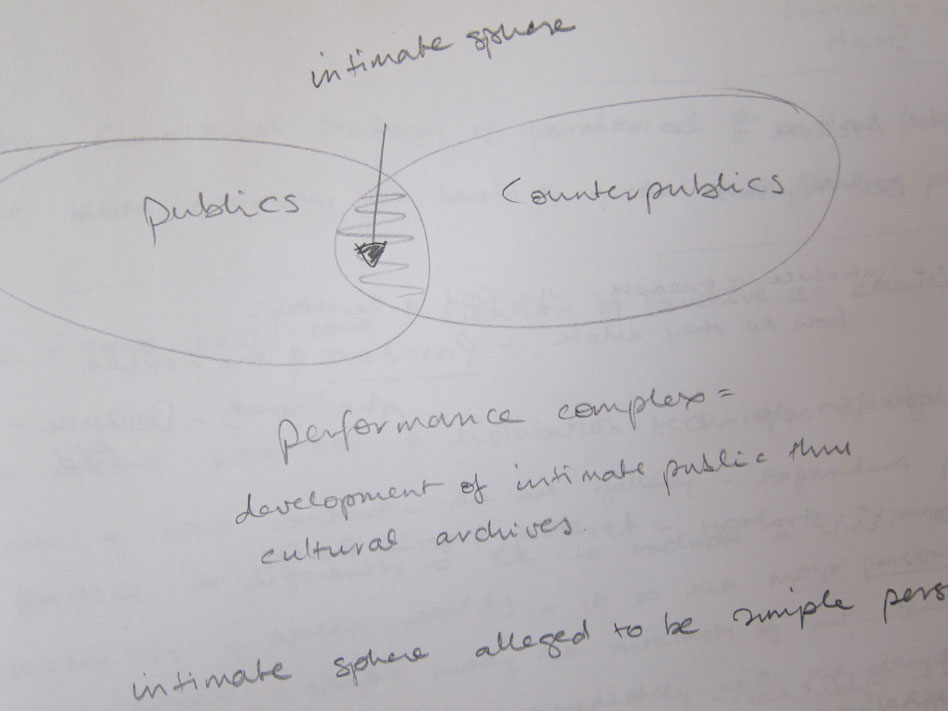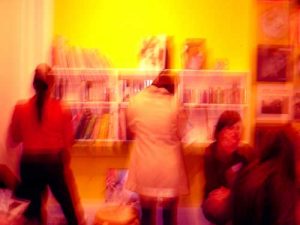Following the theme of covering and uncovering hidden lives and hertories is artist and writer Emma Hedditch’s installation We’re Alive, Let’s Meet! (2005). Hedditch’s installation is one of the five main works commissioned and displayed for the duration of the Her Noise exhibition at the South London Gallery in 2005. Hedditch’s many and often conceptual performances involve a diacritics of covering and uncovering, of closure, disclosure and deciphering. Hedditch’s contribution to the Working Documents exhibition at Laverena in Barcelona in 2002 consisted of covering the window and sign to the gallery of the exhibition from the outside. From a later performance at an artist space in Williamsberg, New York, Hedditch’s action involved covering members of an audience that had gathered to hear Mattin, Margarita Garcia and Marcia Bassett perform. Hedditch explains this interest as one of how “relations produce physical and psychological spaces for experimentation, research, self-organising and direct action, including performing” – what may be understood as a practice of social production (transcribed Heditch, Affinities, Networks and Heroines, Her Noise: Feminisms and the Sonic Symposium, 2012 ). She does this, I want to suggest, not so much as a “tool of differential diagnosis, but as a tool for better seeing [hearing] differentials of practice” (Sedgwick 2003: 130). This signifies a shift in the notions of performance and performativity, particularly in regard to the study of music that Alejandro Madrid puts forward, which I expand upon through my thinking of We’re Alive, Let’s Meet!, as a means for considering musical performativity as always social rather than as a purely self-referential musicality (Madrid 2009).
Hedditch’s installation We’re Alive, Let’s Meet! is a performative sound-based art installation which uses the materials of the Her Noise Archive – collected by Hedditch with Irene Revell, Lina Džuverovic and Anne Hilde Neset – as a basis from which to explore socio-musical processes, practices and publics. We’re Alive, Let’s Meet! culminated in a series of six ‘get-togethers’ over the course of the Her Noise exhibition at the South London Gallery in 2005. Hedditch expresses her intentionality in using the term ‘get-together’ “so as to not be a workshop or a talk or a lecture and simply around the idea of people coming together” (transcribed Hedditch Her Noise Archive interview, 2006). Each weekly get-together proceeded from a particular “theme or an idea to begin the discussion and they were open to anybody who wanted to come” (ibid). Guests such as Tobi Vail and Alison Wolfe, from riot grrrl bands Bikini Kill and Bratmobile, Amy Spencer author of “DIY: The Rise Of Lo-Fi Culture”, independent film maker Vivienne Dick, sound artists Melanie Clifford and Isa Suarez as well as members from Creative Routes1, a group established to connect mental health and creativity, among others, contributed their time and experience to the get-togethers.
Hedditch outlines the progression of the work over the six week period of the installation’s get-togethers as functioning “on different levels” where “in the early period it was more focused around what the function of the archive was and then as it developed it became more participatory and people could bring things and actively make exchanges, to bring things and to leave [them] in the archive” (ibid). Participants of the get-togethers explored “relations between historical acts”, “ways of forming collaborations” and the ways in which this information can “transform and inspire action” through performance and art-making (ibid). Further, the get-togethers used the collected materials from the Her Noise Archive in the process of the installation, the tangible and ephemeral results of which were then refolded back into the archive. For instance, one of the get-together’s focused upon zine production exploring the zines collected in the archive, inviting people who had made their own zines to share them with the archive and actually making zines which were then added to the archive.
Performative Composition
We’re Alive, Let’s Meet!, similarly, yet slightly differently to Cathy Lane’s Hidden Lives, may be perceived as enacting a further performative shift in thinking about sound, music and culture. Ethnomusicologist and cultural theorist Alejandro Madrid, writing in “Transcultural Music Review” (2009), explains the “opposition to the use of the concept of performativity” he found himself confronted with specifically “when used in conjunction with the act of composition” within the field of musicology (Madrid 2009: 1). Madrid’s submission paper to the journal, focusing on what he called “performative composition” was rebuked by an English language musicology journal reviewer who explained that “the term “performativity” had a long history in music studies – used in reference to the act of musical performance, music-making, or musical interpretation” (ibid). Madrid’s use of the term thus conflicted with the reviewer’s with the contention arising because Madrid’s use of performativity in the context of composition “seemed to disrupt the composition/performance dyad” (ibid). Of course though, it does more than this, performativity as used in cultural and performance studies disrupts the entire relay of meaning making and thus notions of authorship, authority and truth in the sex/gender/sexuality triad as much as in the composer/performer/audience triad. The challenge to traditional beliefs about authority and authorship as the sole preserve of a composer, or as dictated by heteronormative notions of sex as primary, occurs through a shift or reversal in the locus of meaning-making onto the audience (or onto sexuality). It is then the audience (or sexuality) that in effect acquires compositional authority through their listening which performs the work within such a paradigm. The performative shift in the locus of meaning-making upon the audience through We’re Alive, Let’s Meet! provides a means through which to trace the affective resonance and ephemeral noise of this work which would otherwise remain inaudible because actually, no normatively audible nor easily documentable object, such as a finished traditional composition of this work esists.
Madrid explains how the term performativity is applied within music scholarship where traditionally “the study of performance has meant the study of a wide variety of music-making paradigms” focused upon questions that “remained within the realm of the rendition of a musical text” i.e. the performance of a score according to a per-ordained and closed system of musical form (Madrid 2009: 3). This more traditional paradigm of the musical text is primarily focused upon answering questions in regard to how to make “such texts accessible to listeners, musical performances as texts, or at best, how the notions of performance and composition might collapse in improvisation” (ibid). These questions, Madrid asserts, keep the focus of performativity upon “the means by which music is created or re-created in performance” as the classic scenario of music as a closed and self-referential system rather than opening up to questions that can address the social process of composition itself (ibid).
In contrast to normative “traditional music scholarship”, Madrid links theories of performativity to performance studies primarily through J.L. Austin and philosophical concerns about the social construction of language (Madrid 2009: 3). He outlines the development of the term through Northern and Southern American performance studies, further citing Butler’s post-structuralist approach as opening “the door for the use of the notion of performativity not only to analyse speech or bodily actions but also to approach other cultural discourses and manifestations in terms of processes” (Madrid 2009: 4). This, Madrid explains, “enabled a shift away from asking about the meaning of sound in culture and society into asking about the social and cultural uses of that sound”, raising questions about what sound does or what it “allows people to do” rather than questions about what sound is or might mean musically. Considering soundworks, musics, installations and compositions then “as processes within larger social and cultural practices” enables an appreciation of how such works “can help us understand these processes as opposed to how these processes help us understand music” (ibid). It is through this composition/performance/audience triadic disruption that Madrid re-figures performance as composition created through the social act of listening. He traces the movement of this thinking in sound and performance studies as seeking to expand “understandings of what a musical performance could be” through an idea of music as a “part of larger performance complexes” (Madrid 2009: 10). Citing case studies that analyse the “performance of race and nationality through music” Madrid states that,
Performance complexes operate within historical processes, making us understand that music acquires meaning and significance as it articulates a variety of practices (from dance to reception to social discourse to listening) and processes that go well beyond the sounds and the texts that represent them (Madrid 2009: 10).
In other words, music acquires meaning through the social relations that are both embedded within and that ensue from its use, expanding well beyond the artificial boundaries of music as a self-referential system. Music, its production and its meaning considered in this way is an imminently social and historically changeable process. Madrid’s analysis of what he thus calls performative composition is one that collapses the distinction between composer, performer and audience through the analysis of artefacts, experiences and processes, such as concerts, media, video footage, memorials, technology, activism and memory, which are all considered as “part of a larger performance complex” (ibid). Such performance complexes, Madrid proposes, may “be made into cultural citations that mobilise powerful emotions and structures of feeling that in turn could be used as sites for the development of cultural memberships” (Madrid 2009: 4). I want to follow Madrid’s thinking to suggest that the “performance complex” elements Madrid analyses which move “beyond the sounds and the texts that represent them”, in Hedditch’s installation are zines and musics as much as they are conversations, social gatherings and shared memories (Madrid 2009: 4, 10). These ‘performance complexes’ are themselves the performative acts which materialise the composition of this installation through a shared performance of audition that composes a ‘kind of public’. Hedditch explains this process as,
…more in keeping in the ways in which a lot of the music and the ways this kind of music is produced and distributed and the kind of communities around that kind of music evolved. So it doesn’t strip away all of that social interaction. So we set up also just as a space here…to form around the archiving project and the whole exhibition, to form a mini kind of community that gets together and exchanges information (transcribed Hedditch South London Gallery, Her Noise Archive, 2005).

